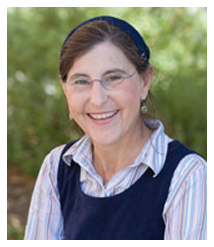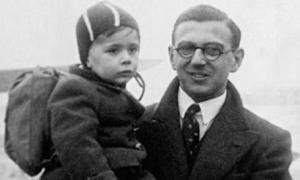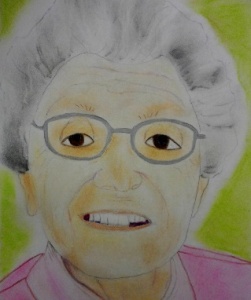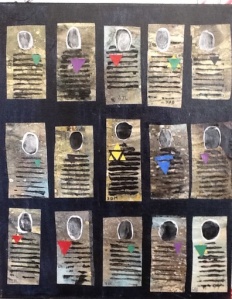Lauriet Bellet
 Last night, the news reported the death of Sir Nicholas Winton, aged 106. Sir Nicky’s death allowed me to reflect back, 7+ years, to one of the most meaningful experiences I have ever shared with my students at Oakland Hebrew Day School.
Last night, the news reported the death of Sir Nicholas Winton, aged 106. Sir Nicky’s death allowed me to reflect back, 7+ years, to one of the most meaningful experiences I have ever shared with my students at Oakland Hebrew Day School.
 As a young man in 1939, Winton (who did not know at that time that his family had converted from Judaism) organized a rescue of 669 Czech children, commissioning trains, locating British foster families, raising funds and attempting to bring awareness to the plight of European Jews. I became aware of this story, after previewing the film The Power of Good, which documented the story of the rescue. The story itself did not come to public light until, 50 years later, Winton’s wife found his old scrapbooks in the attic. Happily, my Middle School Shoah students found the story as compelling as I did, and set about designing an experience which would lead to their own greater learning and teach others. Together, they decided to recreate their personal imagery of Winton’s home office. Dividing the tasks, students hand stamped manila luggage tags (similar to those worn by the Winton rescuees) with numbers from 1 -669 (the practical reality of constrained space set in!). OHDS families loaned us antique typewriters on which to recreate the Winton letters and lists. Other students took on the task of recreating Winton’s scrapbooks and designing a trunk that would display all their materials. I confess that one student became quite skilled in copying Nicholas Winton’s signature.
As a young man in 1939, Winton (who did not know at that time that his family had converted from Judaism) organized a rescue of 669 Czech children, commissioning trains, locating British foster families, raising funds and attempting to bring awareness to the plight of European Jews. I became aware of this story, after previewing the film The Power of Good, which documented the story of the rescue. The story itself did not come to public light until, 50 years later, Winton’s wife found his old scrapbooks in the attic. Happily, my Middle School Shoah students found the story as compelling as I did, and set about designing an experience which would lead to their own greater learning and teach others. Together, they decided to recreate their personal imagery of Winton’s home office. Dividing the tasks, students hand stamped manila luggage tags (similar to those worn by the Winton rescuees) with numbers from 1 -669 (the practical reality of constrained space set in!). OHDS families loaned us antique typewriters on which to recreate the Winton letters and lists. Other students took on the task of recreating Winton’s scrapbooks and designing a trunk that would display all their materials. I confess that one student became quite skilled in copying Nicholas Winton’s signature.

This survivor, who died this past year, derived great joy from the portrait rendered by Naomi – gr 8
Since that time, students at OHDS participate in an art learning experience related to the Shoah. Somehow, I rarely write about this learning because Yom HaShoah falls at such a busy time of the year and Kristallnacht comes so soon after the fall holidays. Shoah art learning must go far beyond the gratuitous display of yellow star badges and Nazi symbolism. It must engage the thinker and touch the individual and collective heart of the students. We operate in an era when resources, stories and photos are readily available. The challenge is in finding that which will grip you and your learners.
Often, I derive inspiration from the survivors who come to speak to our students. In 2014, my 8th grade students drew portraits of survivors they had come to know; survivors whom they hosted for lunch and who graciously their stories.
This past year, I found, in my desk, a worn paper, given to me by a survivor, which listed the identity badges used for some prisoner groups in Auschwitz. From this creased and frayed paper, students began to contemplate the nature of personal identity and whether or not it can ever be fully stripped from any individual. The resulting collaborative work included both students (grades 5-8) and faculty. Inspired from a piece of art, actually created in Buchenwald, called Our Biographies by Jozef Szajna, OHDS artists worked on papers (photos from old National Geographic magazines) on which we had denatured the images with a natural solvent (Citra-Solv) in order to blur the identity of the photo. Then, using stripped corrugated cardboard we printed stripes (similar what was done in Our Biographies), onto rectangles of the denatured papers, to imitate the clothing in the camp. Our Biographies was about identity in the midst of a nightmare where the goal was to strip inmates of everything personal. In the original, prisoners used fingerprints to create heads atop the stripes. We did the same. Artists used black tempera paint and practiced to achieve the best fingerprint they could manage. When the striped and fingerprinted figure was complete, OHDS artists studied the meaning of the various camp badges; finally selecting one for themselves. To culminate the effort, all the figures were mounted together (again in the style of Our Biographies).
In order to write the final artist statement (copied below), all the OHDS participants engaged in deep discussion to evaluate whether or not an individual could truly be stripped of identity. The paradox of the badges, which actually were displays of identity, was seriously considered.
From the Winton experience years ago, when we probed the nature of heroism, to reflective portraits, to questions of identity, Shoah education at Oakland Hebrew Day School involves both the teacher and the learner in profound thought and personal questioning. While enjoying summer, this is a good opportunity to learn and seek subjects that can engage us all, teacher and learner. Please take the time to gift yourself and study the work of Sir Nicholas Winton. Pitome Publlishing offers the video The Power of Good; it is gripping and inspiring. If you would like assistance developing a Shoah curriculum experience, for your school, please contact me. (lbellet@ohds.org)
IDENTITY—THE ARTIST STATEMENT
 When asked to define the essence of “identity,” student artists (grades 5,6, &7) at Oakland Hebrew Day School, reflected on one’s name, appearance, heritage, strengths and struggles, skills and deficits. As a group, we came to equate a person’s basic identity with their soul and their intrinsic humanity. With identity, come strength and honor.
When asked to define the essence of “identity,” student artists (grades 5,6, &7) at Oakland Hebrew Day School, reflected on one’s name, appearance, heritage, strengths and struggles, skills and deficits. As a group, we came to equate a person’s basic identity with their soul and their intrinsic humanity. With identity, come strength and honor.
Inspired by the art piece Our Biographies, done by Polish theatrical artist Jozef Szajna (1922-2008) while imprisoned in Buchenwald (1944-1945) we attempted to explore the Nazis’ systematic effort to rob Jews, and individuals in other minority groups, of their basic identities. Our Biographies (pictured below) depicts identical rows of stripes, alluding to prison garb. Each set of stripes is topped by a print which symbolizes an individual’s head. Upon closer examination, you can see that each head is applied as a unique thumbprint. No matter what else was taken from these internees, no one could eradicate the uniqueness of their fingerprints.
By eradicating the identities of those who did not fit their own, precisely defined, Aryan identification parameters, the Nazis felt emboldened. Paradoxically though, they assigned an identity to everyone they imprisoned. Although in the public community Jews were required to wear the infamous yellow star badge, in the death camps, the Nazis operated according to a status classification system for the inmates. Badges, comprised of specific colors and shapes, (please refer to the chart presented within this art) was designed to afford the guards awareness, at a glance, of what “crime” a person was associated with, whether or not they had attempted a prior escape, and if they had been detained multiple times.
Identity is a collection of individual pieces of art. The very background color (Payne’s grey), itself lacks identifiable clarity. Is it grey; is it indigo? OHDS artists worked on background papers that had once been richly colored photographs in National Geographic magazines. By applying a solvent to these photos, we denatured each to the point that it lost its original identifying characteristics. Even so, each maintains a certain uniqueness. To print prison garments, OHDS artists used corrugated cardboard, stripped of its outer covering. Informed by the aforementioned Our Biographies, we used our thumbprints for each head. Since concentration camp prisoners were denied names and were assigned numbers, none of these prints are signed. To identify the artists, we included student art codes (grade and initials). Participating teachers added a number pertinent in their lives. After probing more extensively into the Nazi classification categories, every artist created a badge to, ironically, further identify each individual representation.
The resulting art piece puts forth the question of whether or not an individual can, even in extremis, be robbed of a personal and unique identity. It is, we hope, a profound, albeit limited, vision of the millions of individuals deemed unworthy, by the Nazis, of soulful, honorable, identity.

